Welcome to our San Diego Gardening Guide blog! Discover tips and tricks for thriving gardens in our sunny, coastal climate. From succulent care to organic veggies, we’ll guide you through every season, ensuring your garden flourishes year-round. Join our community of passionate gardeners and let’s grow together!
1. Climate in San Diego
San Diego’s climate and soil composition offer a unique environment for gardening and agriculture, characterized by its Mediterranean climate and varied soil types. Here’s a detailed look into each aspect:
- Mild, Wet Winters: From December to March, temperatures typically range from 50°F to 65°F (10°C to 18°C). Rainfall is relatively low, averaging about 10 inches (250 mm) annually, most of which occurs during these months. This period supports the growth of cool-season crops and provides necessary moisture for perennial plants.
- Hot, Dry Summers: From June to September, temperatures can soar to 85°F (29°C) or higher, particularly inland. Coastal areas benefit from ocean breezes, which moderate temperatures somewhat. The summer drought conditions favor plants that are drought-tolerant and adapted to dry soils.

2. Soil in San Diego
The soil composition in San Diego varies widely across different regions, affecting water retention, aeration, and nutrient availability:
- Coastal Areas: Often characterized by sandy soils, these areas have excellent drainage but can struggle to retain nutrients and moisture. Sandy soils are ideal for plants that prefer well-drained conditions, such as succulents and some herbs.
- Inland Regions: These areas might have heavier, clay soils, which retain more moisture but can become compacted and poorly aerated. Clay soils can be challenging for root growth but are nutrient-rich and suitable for a variety of fruit trees and shrubs if properly managed.
Conducting a Soil Test
To optimize planting strategies, conducting a soil test is essential:
- Sample Collection: Collect soil samples from different parts of your garden to get a comprehensive understanding of the soil composition. Use a clean tool to take samples from the surface to a depth of about 6 inches (15 cm).
- Testing Parameters: Soil tests typically measure pH, nutrient levels (such as nitrogen, phosphorus, and potassium), and soil texture (percentage of sand, silt, and clay).
- Understanding pH: San Diego soils can vary in pH, but many tend to be slightly acidic to neutral (pH 6-7). Certain plants prefer specific pH ranges, so adjusting soil pH can improve plant health and productivity.
- Amending Soil: Based on test results, you might need to add lime to raise the pH (make it more alkaline) or sulfur to lower the pH (make it more acidic). Organic matter, like compost, can improve soil structure and nutrient content for both sandy and clay soils.

Soil Management Practices
By understanding and adapting to San Diego’s climate and soil conditions, gardeners can create thriving landscapes and productive gardens that take full advantage of the unique environmental conditions.
- Improving Sandy Soils: Add organic matter such as compost or well-rotted manure to increase nutrient content and moisture retention. Mulching can also help reduce evaporation and maintain soil moisture.
- Amending Clay Soils: Incorporate organic matter to improve drainage and aeration. Raised beds or berms can help with water management in heavy soils. Avoid working clay soils when wet to prevent compaction.
- Mulching: Use mulch to conserve soil moisture, moderate soil temperature, and suppress weed growth. Mulch also adds organic matter as it decomposes, enhancing soil fertility over time.
3. Best Plants for San Diego
San Diego’s Mediterranean climate and varied soil conditions make it an excellent location for a diverse range of plants, including native species, drought-tolerant plants, and a variety of vegetables.
Native Plants
Native plants are well-adapted to San Diego’s climate and soil, requiring minimal water and maintenance. They are also beneficial for local wildlife and ecosystems.
- California Poppy (Eschscholzia californica)
- Description: Bright orange flowers that bloom in spring.
- Benefits: Low water requirement, attracts pollinators, and easy to grow.
- Manzanita (Arctostaphylos spp.)
- Description: Evergreen shrubs with smooth red bark and small white or pink flowers.
- Benefits: Drought-tolerant, provides habitat for wildlife, and has attractive foliage and bark.
- Ceanothus (Ceanothus spp.)
- Description: Evergreen shrubs or small trees with clusters of blue or white flowers.
- Benefits: Low water needs, nitrogen-fixing properties, and supports local pollinators.

Drought-Tolerant Plants
These plants thrive in San Diego’s hot, dry summers and require minimal watering once established.
- Agave (Agave spp.)
- Description: Succulents with rosettes of thick, fleshy leaves.
- Benefits: Extremely drought-tolerant, striking architectural form, and low maintenance.
- Aloe (Aloe spp.)
- Description: Succulents with thick, spiky leaves and tubular flowers.
- Benefits: Drought-tolerant, medicinal uses (e.g., Aloe vera), and attractive blooms.
- Cacti (various species)
- Description: Wide variety of shapes and sizes, often with spines and beautiful flowers.
- Benefits: Very low water requirement, interesting forms, and colorful blooms.
- Lavender (Lavandula spp.)
- Description: Aromatic shrubs with purple flowers.
- Benefits: Drought-tolerant, attracts pollinators, and useful for culinary and medicinal purposes.
- Rosemary (Rosmarinus officinalis)
- Description: Evergreen shrub with fragrant, needle-like leaves and blue flowers.
- Benefits: Drought-tolerant, culinary uses, and attracts pollinators.
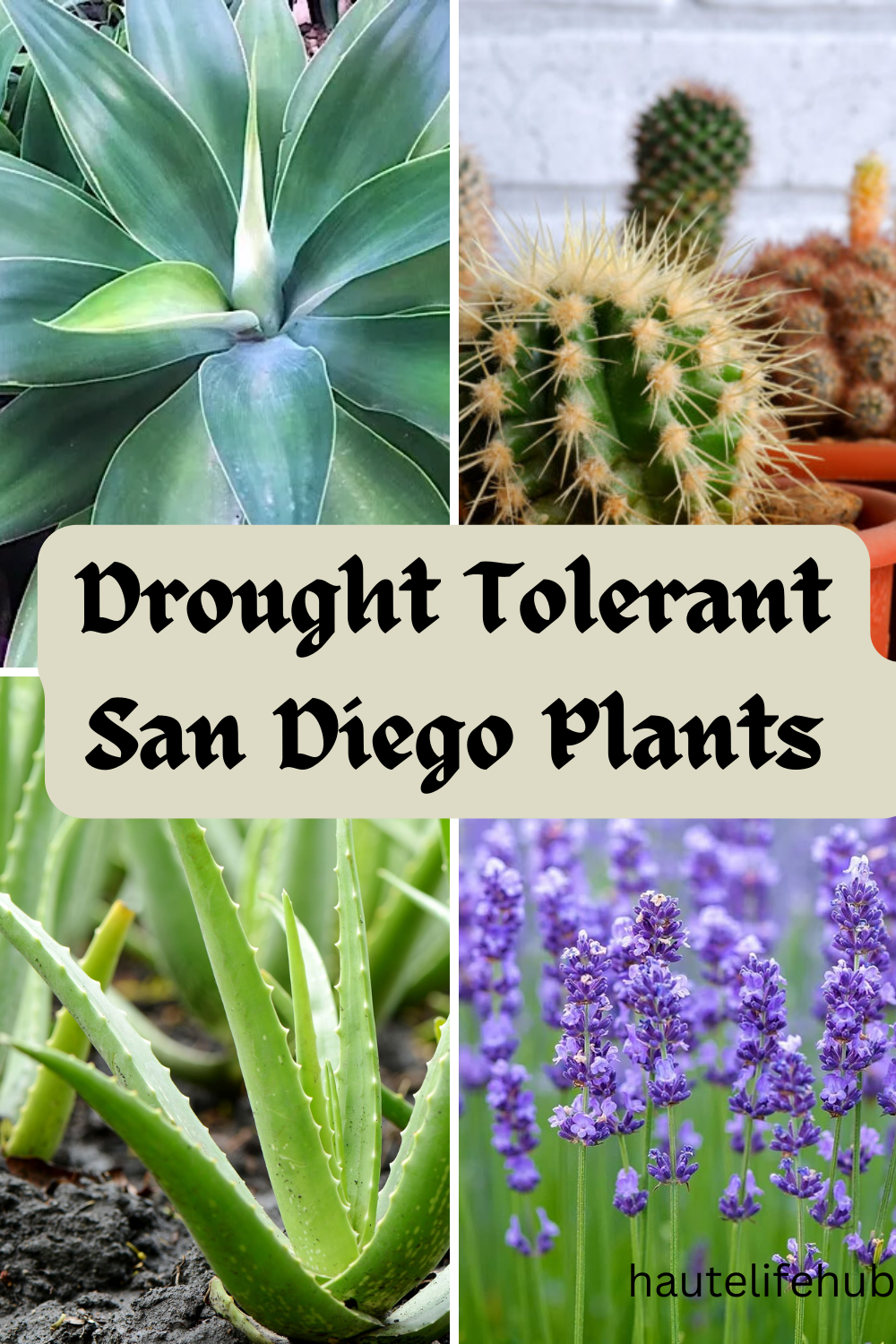
Vegetables
San Diego’s climate allows for year-round vegetable gardening, with different crops thriving in cool and warm seasons.
- Cool-Season Crops (Fall and Winter)
- Lettuce (Lactuca sativa): Various varieties thrive in cooler temperatures and can be harvested within a few weeks.
- Spinach (Spinacia oleracea): Grows quickly in cooler weather and is nutrient-rich.
- Peas (Pisum sativum): Prefer cooler weather and can be grown as snap, snow, or shelling peas.
- Warm-Season Crops (Spring and Summer)
- Tomatoes (Solanum lycopersicum): Thrive in warm weather and require full sun; many varieties are available.
- Peppers (Capsicum spp.): Both sweet and hot varieties flourish in warm temperatures.
- Cucumbers (Cucumis sativus): Grow quickly in warm weather and require consistent watering and full sun.

4. Watering Tips
Watering is crucial in maintaining a healthy garden, especially in a climate like San Diego’s, which features hot, dry summers and mild, wet winters. Here are some detailed watering tips to help you make the most of your garden’s water use:
Efficient Irrigation
Drip Irrigation
Drip irrigation is a watering system that delivers water directly to the roots of plants, using a network of tubes and emitters. It’s designed to be efficient and minimize water usage by applying water slowly and directly to the soil.
- Advantages: Delivers water directly to the plant roots, minimizing evaporation and runoff. It’s highly efficient and can be tailored to the specific needs of each plant.
- Installation: Lay drip lines or tubing along plant rows or beds. Use emitters to control the flow of water to individual plants. Ensure that the system is properly maintained and checked regularly for clogs or leaks.
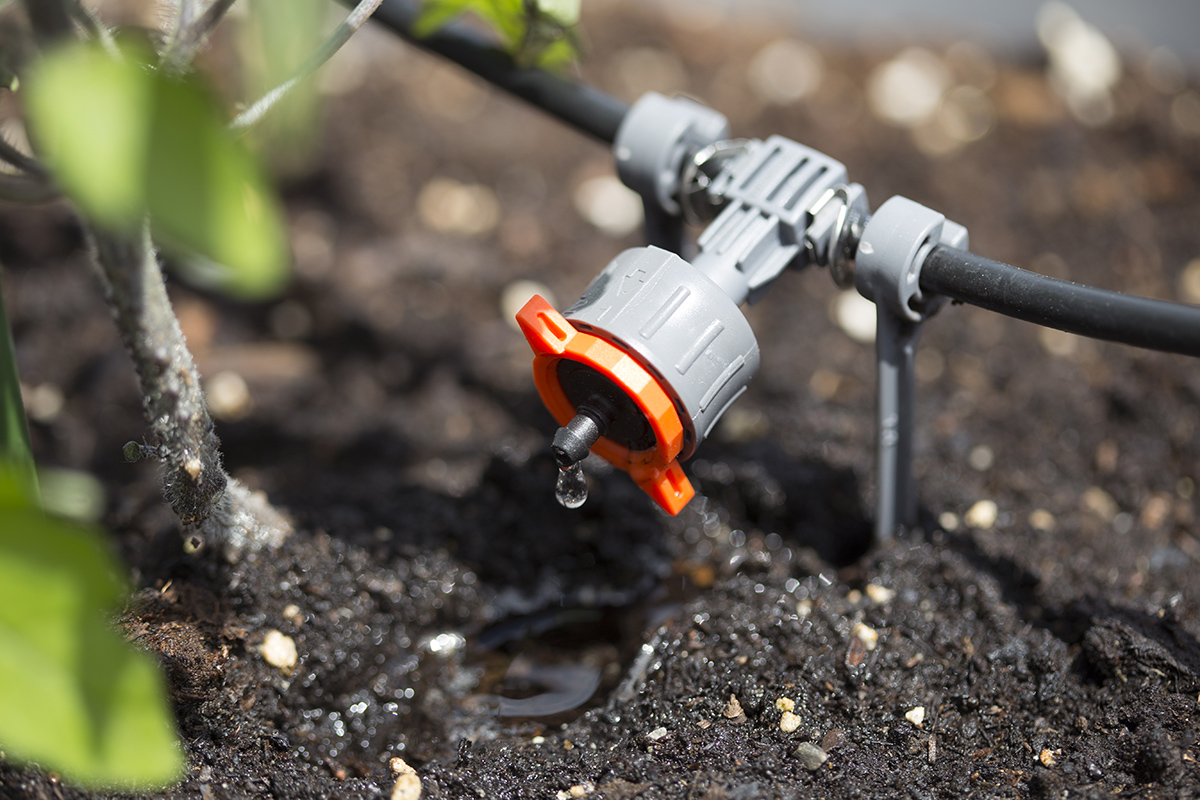
Soaker Hoses
Soaker hoses are a type of irrigation hose designed to slowly and evenly release water directly to the roots of plants. They are typically made from recycled rubber or polyethylene and have tiny pores or perforations along their length.
- Advantages: Similar to drip irrigation, soaker hoses release water slowly along their length, allowing for deep soil penetration with minimal evaporation.
- Installation: Lay soaker hoses on the soil surface or slightly buried under mulch. Connect them to a timer to control watering duration and frequency.

Water Timing
“Water timing” typically refers to the practice of timing when and how much water is applied to plants, particularly in gardening or agriculture. It involves scheduling watering sessions based on factors such as plant type, soil moisture, weather conditions, and time of day.
- Early Morning Watering: Watering in the early morning (before 10 a.m.) reduces evaporation and allows plants to absorb moisture before the heat of the day.
- Evening Watering: Watering late in the evening (after 6 p.m.) can also be effective, but it’s important to avoid wet foliage overnight, which can lead to fungal diseases.
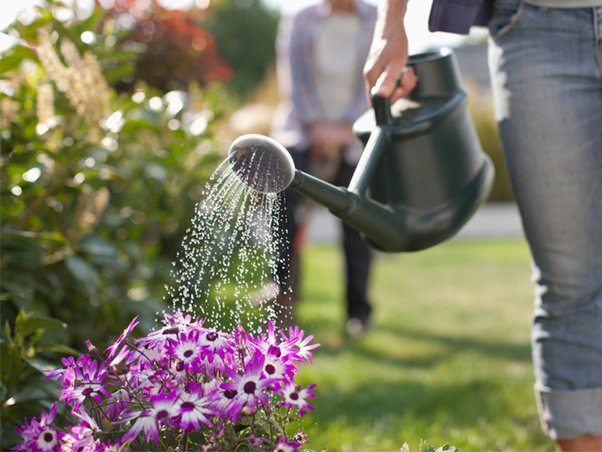
Mulching
- Benefits of Mulch
- Moisture Retention: Mulch reduces evaporation from the soil, helping to retain moisture and reduce the frequency of watering.
- Weed Suppression: A thick layer of mulch helps prevent weed growth, which can compete with garden plants for water and nutrients.
- Temperature Regulation: Mulch insulates the soil, keeping it cooler in the summer and warmer in the winter.
- Types of Mulch
- Organic Mulch: Materials like straw, wood chips, bark, compost, and leaves. Organic mulch breaks down over time, adding nutrients to the soil and improving its structure.
- Inorganic Mulch: Materials like gravel, pebbles, or landscape fabric. Inorganic mulch does not decompose, so it doesn’t improve soil fertility but can be effective in areas where long-term weed suppression and moisture retention are needed.
- Application
- Depth: Apply a layer of mulch 2-4 inches deep around plants. Ensure the mulch is not piled up against the plant stems or trunks to prevent rot and disease.
- Coverage: Spread mulch evenly, covering the entire root zone of the plants. Leave a small gap around the base of plants to avoid direct contact with the stems.
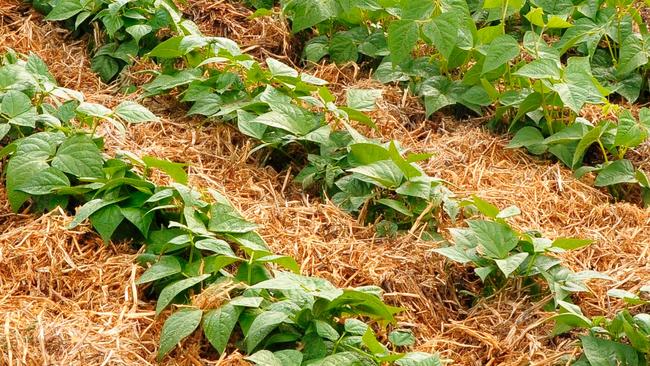
Additional Watering Tips
- Soil Moisture Monitoring
- Check Soil Moisture: Regularly check the soil moisture by inserting your finger or a moisture meter into the soil. Water when the top 1-2 inches of soil feel dry.
- Deep Watering: Water deeply but infrequently to encourage deep root growth. Shallow, frequent watering can lead to weak, shallow root systems.
- Plant Grouping
- Hydrozones: Group plants with similar water needs together to ensure efficient water use. This allows you to tailor watering schedules and amounts to the specific needs of each group.
- Xeriscaping: Consider xeriscaping, a landscaping method that reduces the need for irrigation by using drought-tolerant plants and efficient irrigation practices.
- Rainwater Harvesting
- Rain Barrels: Collect rainwater from roof gutters in rain barrels. This free water source can be used for garden irrigation during dry periods.
- Rain Gardens: Design rain gardens to capture and utilize rainwater runoff. These gardens can help recharge groundwater and reduce the need for supplemental irrigation.
5. Seasonal Gardening
Seasonal gardening in San Diego involves adapting your gardening practices to the unique climate and weather patterns throughout the year. Here is a detailed guide for each season to help you make the most of your garden:
Spring
Tasks:
- Planting Warm-Season Vegetables and Annuals: This is the ideal time to plant tomatoes, peppers, cucumbers, squash, and other warm-season crops. Annual flowers like marigolds, zinnias, and petunias can also be planted now.
- Starting Seeds Indoors: Begin seeds for vegetables and flowers indoors 6-8 weeks before the last expected frost. Transplant seedlings to the garden after the danger of frost has passed.
- Soil Preparation: Add compost or organic matter to garden beds to enrich the soil and improve drainage.
Tips:
- Monitor Weather: Keep an eye on the weather forecast and be prepared to protect young plants from unexpected cold snaps.
- Fertilize: Use a balanced fertilizer to give your plants a strong start.
Summer
Tasks:
- Efficient Watering: Implement drip irrigation or soaker hoses to minimize water waste. Water early in the morning or late in the evening to reduce evaporation.
- Mulching: Apply a thick layer of mulch around plants to retain moisture, suppress weeds, and regulate soil temperature.
- Harvesting: Regularly harvest vegetables like tomatoes, cucumbers, beans, and squash. This encourages continued production and prevents overripe produce from attracting pests.
- Pest Management: Monitor plants for pests and diseases. Use organic or integrated pest management (IPM) techniques to control infestations.
Tips:
- Shade Protection: Use shade cloth to protect sensitive plants from intense midday sun.
- Deep Watering: Water deeply and less frequently to encourage deep root growth.
Fall
Tasks:
- Planting Cool-Season Crops: Sow seeds or transplant seedlings of lettuce, spinach, kale, broccoli, carrots, and peas. These crops thrive in the cooler temperatures of fall and winter.
- Planting Native Plants: Fall is the best time to plant native species like California poppy, manzanita, and ceanothus, as they establish roots during the cool, moist winter months.
- Tree and Shrub Planting: Plant trees and shrubs now to allow their root systems to develop before the heat of the next summer.
Tips:
- Soil Amendment: Add compost or other organic matter to improve soil structure and fertility.
- Mulch Renewal: Refresh mulch layers to maintain moisture and temperature regulation.
Winter
Tasks:
- Pruning: Prune deciduous trees and shrubs while they are dormant. Remove dead, damaged, or diseased branches and shape the plants as needed.
- Frost Protection: Protect sensitive plants from frost by covering them with frost cloths or blankets during cold nights.
- Garden Clean-Up: Clear out any dead or diseased plant material to reduce the risk of pests and diseases in the coming growing season.
Tips:
- Soil Care: Avoid working the soil when it’s wet to prevent compaction. Instead, focus on planning and preparing for spring planting.
- Tool Maintenance: Clean, sharpen, and repair garden tools to ensure they are ready for the next season.
General Tips for Year-Round Gardening
- Soil Testing: Conduct soil tests periodically to understand nutrient levels and pH. Amend soil based on test results to maintain optimal growing conditions.
- Composting: Maintain a compost pile to recycle garden waste and create a valuable soil amendment.
- Pest and Disease Monitoring: Regularly inspect plants for signs of pests and diseases. Early detection and treatment can prevent widespread issues.
- Garden Planning: Keep a garden journal to track planting dates, harvest times, and any issues encountered. This helps with planning future gardens and improving yields.
6. Pest Management
Pest management is a crucial aspect of maintaining a healthy garden, and Integrated Pest Management (IPM) offers a comprehensive approach that minimizes the use of chemical pesticides. Here’s a detailed guide on implementing IPM and encouraging natural predators in your garden:
Integrated Pest Management (IPM)
IPM is a sustainable approach to managing pests by combining multiple techniques that are safe for the environment and effective in the long term. The core components of IPM include:
- Monitoring and Identification
- Regular Inspection: Regularly inspect plants for signs of pests, diseases, or damage. Early detection is key to effective control.
- Proper Identification: Correctly identify pests to choose the most effective control methods. Not all insects are harmful; some are beneficial.
- Preventive Cultural Practices
- Crop Rotation: Rotate crops each season to prevent pests that target specific plants from becoming established.
- Diverse Planting: Mix different types of plants to reduce the likelihood of pest infestations.
- Sanitation: Keep the garden clean by removing weeds, debris, and old plant material that can harbor pests.
- Biological Control
- Natural Predators: Introduce or encourage beneficial insects that prey on garden pests.
- Parasites and Pathogens: Use beneficial nematodes, fungi, or bacteria that target specific pests without harming other organisms.
- Mechanical and Physical Controls
- Barriers and Traps: Use row covers, sticky traps, or barriers to prevent pests from reaching plants.
- Hand-Picking: Physically remove pests from plants when infestations are light.
- Chemical Controls
- Selective Pesticides: When necessary, use pesticides that target specific pests and have minimal impact on beneficial insects and the environment. Organic or natural pesticides are preferred.
- Spot Treatment: Apply pesticides only to affected areas rather than the entire garden.
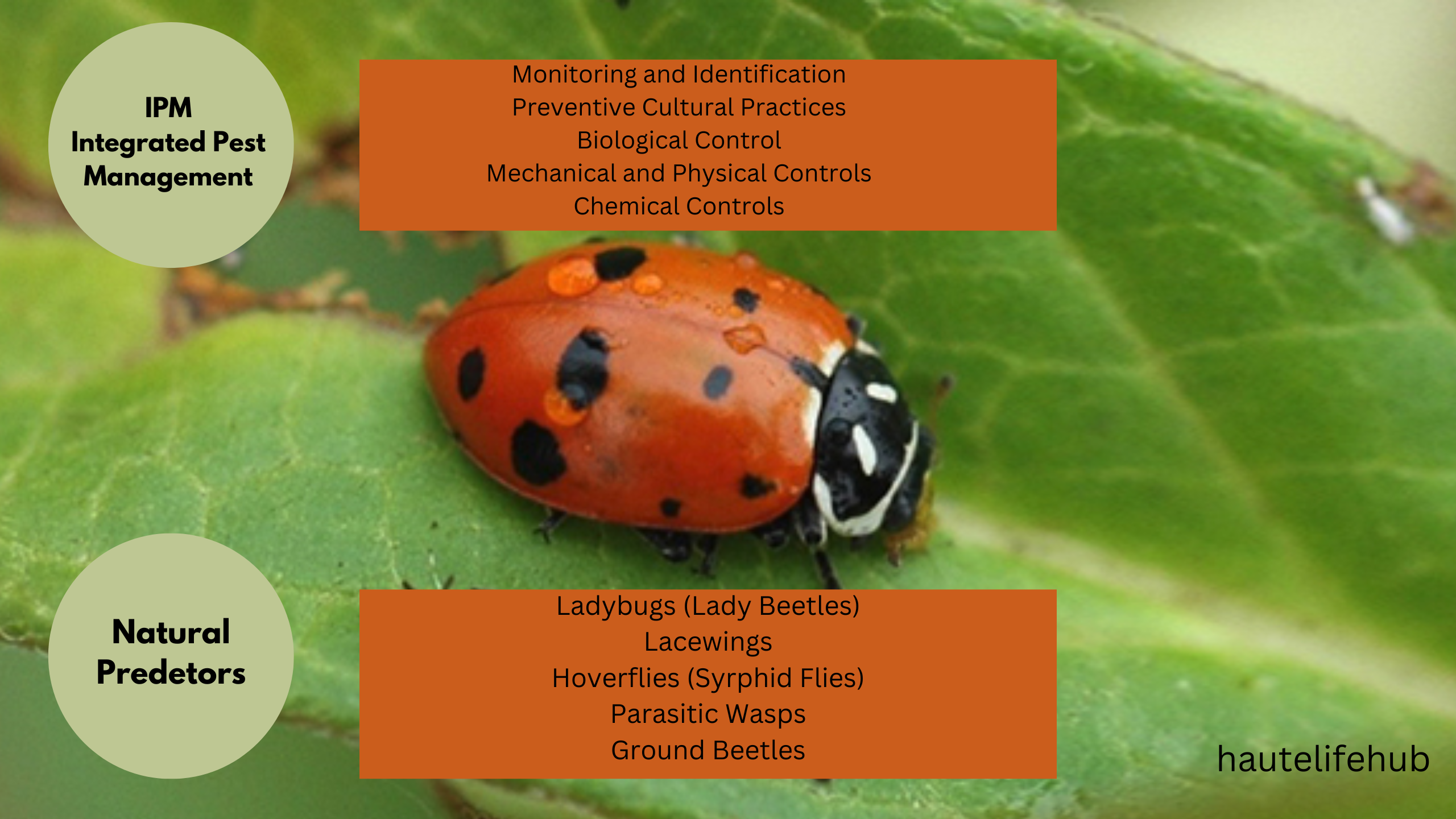
Natural Predators
Encouraging natural predators is a key component of biological control. Beneficial insects can help keep pest populations in check. Here are some common natural predators and how to attract them:
- Ladybugs (Lady Beetles)
- Pests Targeted: Aphids, scale insects, and mites.
- Attracting Ladybugs: Plant dill, fennel, yarrow, and marigold. Avoid broad-spectrum insecticides that can kill ladybugs.
- Lacewings
- Pests Targeted: Aphids, caterpillars, mealybugs, and whiteflies.
- Attracting Lacewings: Plant tansy, cosmos, dill, and dandelion. Provide a source of water, like a shallow dish with pebbles.
- Hoverflies (Syrphid Flies)
- Pests Targeted: Aphids and small caterpillars.
- Attracting Hoverflies: Plant alyssum, calendula, and sweet clover. Maintain a pesticide-free garden to protect hoverfly larvae.
- Parasitic Wasps
- Pests Targeted: Caterpillars, aphids, and whiteflies.
- Attracting Parasitic Wasps: Plant nectar-rich flowers like yarrow, dill, and parsley. Avoid using broad-spectrum insecticides.
- Ground Beetles
- Pests Targeted: Slugs, snails, and root maggots.
- Attracting Ground Beetles: Maintain mulch and leaf litter where ground beetles can hide. Plant perennials that provide cover.
- Spiders
- Pests Targeted: Various insects, including flies, beetles, and moths.
- Attracting Spiders: Provide habitats like dense plantings and mulch. Avoid disturbing webs and shelters.
Additional Tips for Encouraging Natural Predators
- Diverse Plantings: A variety of plants can provide food and shelter for beneficial insects throughout the growing season.
- Avoid Chemical Pesticides: Use natural or organic alternatives to avoid killing beneficial insects.
- Provide Water: Small water sources can help attract and sustain beneficial insects.
- Create Habitats: Install insect hotels or leave small brush piles and logs for shelter.
7. Local Resources
Accessing local resources can greatly enhance your gardening experience in San Diego, providing you with valuable information, expert advice, and plants well-suited to the local climate. Here’s how you can utilize these resources effectively:
San Diego Botanic Garden
The San Diego Botanic Garden, located in Encinitas, is a premier destination for garden enthusiasts. It features a wide variety of plants from around the world, including many that thrive in San Diego’s climate.
Resources and Benefits:
- Educational Programs: Attend workshops, classes, and lectures on various gardening topics such as plant care, water conservation, and sustainable gardening practices.
- Plant Collections: Explore diverse plant collections, including native plants, succulents, and drought-tolerant species. This can provide inspiration for your own garden.
- Garden Tours: Participate in guided tours to learn about different plant species and garden designs that work well in the local environment.
- Expert Advice: Consult with horticulturists and garden experts available at the garden for specific questions and advice.
How to Utilize:
- Visit Regularly: Frequent visits can help you stay updated on seasonal plants and gardening techniques.
- Join Membership: Becoming a member often provides additional benefits like discounts on workshops and plant sales.
- Participate in Events: Engage in events like plant fairs, gardening festivals, and special lectures to expand your knowledge and network with other gardeners.
University of California Cooperative Extension (UCCE)
The UCCE provides research-based gardening advice and educational resources to help local gardeners succeed.
Resources and Benefits:
- Master Gardener Program: Access to trained Master Gardeners who offer free advice and can answer specific gardening questions.
- Workshops and Classes: Attend classes on topics such as soil health, pest management, and organic gardening.
- Publications and Guides: Utilize a wealth of online publications and guides tailored to the San Diego climate and soil conditions.
- Demonstration Gardens: Visit demonstration gardens managed by the UCCE to see practical applications of sustainable gardening practices.
How to Utilize:
- Consult Master Gardeners: Reach out through hotlines, email, or at local events for personalized gardening advice.
- Download Resources: Access and download free guides and fact sheets from the UCCE website.
- Attend Workshops: Enroll in workshops and webinars to learn from experts about advanced gardening techniques.
Local Nurseries
Local nurseries are valuable resources for purchasing plants that are specifically suited to the San Diego climate and for obtaining expert gardening advice.
Resources and Benefits:
- Climate-Suited Plants: Nurseries stock plants that thrive in the local conditions, including native and drought-tolerant species.
- Knowledgeable Staff: Experienced staff can provide tips on plant selection, care, and troubleshooting common garden problems.
- Garden Supplies: Access to a variety of gardening supplies, including soil amendments, fertilizers, and pest control products.
- Seasonal Plants: Availability of seasonal plants and advice on the best times to plant them.
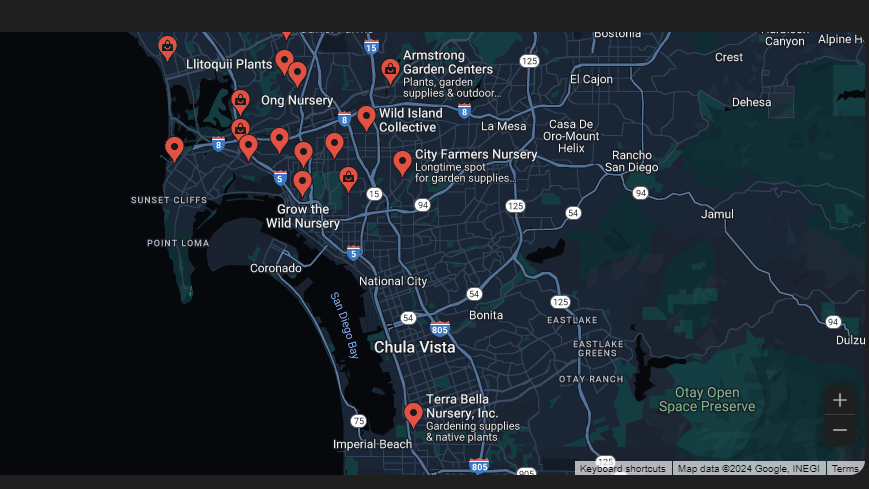
How to Utilize:
- Shop Locally: Buy plants and supplies from local nurseries to ensure they are well-suited to your specific climate and soil conditions.
- Ask for Advice: Don’t hesitate to ask nursery staff for recommendations and advice tailored to your garden.
- Join Loyalty Programs: Many nurseries offer loyalty programs that provide discounts and early access to sales and new plant arrivals.
Additional Local Resources
- Community Gardens: Joining a community garden can provide hands-on experience, a sense of community, and access to shared tools and knowledge.
- Local Gardening Clubs: Join local gardening clubs or societies to connect with fellow gardeners, share tips, and participate in plant swaps and garden tours.
- Online Forums and Social Media: Participate in local gardening groups on social media platforms or forums to exchange advice, share experiences, and stay updated on local gardening events.
Conclusion
- Soil Preparation: Conduct a soil test to understand the composition and pH. Amend soil with organic matter to improve fertility and structure.
- Watering Practices: Use efficient watering methods such as drip irrigation to conserve water. Water early in the morning to reduce evaporation.
- Mulching: Apply mulch around plants to retain moisture, suppress weeds, and improve soil health.
- Plant Selection: Choose plants that are well-suited to your specific microclimate and soil conditions. Native and drought-tolerant plants are excellent choices for low-maintenance gardens.
- Seasonal Planting: Plan your vegetable garden according to the seasons, planting cool-season crops in fall and winter, and warm-season crops in spring and summer.

